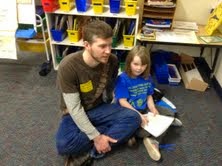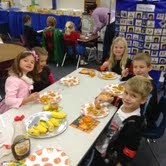I remember the first time I heard
Stellaluna by Janell Cannon. It was 1999 and I was student teaching in a preschool at the lab school connected to the college from which I earned my undergraduate degree in early childhood education.
Stellaluna currently rests at a well-deserved Number 71 on the School Library Journal's list of the 100 top picture books of all time.
Stellaluna is a fruit bat (aka "flying fox") who is separated from her mother after an owl attacks them while they are in search of fruit one night. Stellaluna survives and befriends three baby birds; she eats insects like them and learns to sleep right side up during the night. Unbeknownst to Stellaluna, her mother survives the owl attack. The two types of illustrations in
Stellaluna simultaneously depict the story of Stellaluna and her mother. The pencil drawn miniature illustrations on the top of the left page of the book intricately detail Stellaluna's mom's relentless search for Stellaluna after the owl attack. The full blown, colored, scientifically correct illustrations on the right depict the story of Stellaluna's journey after the owl attacked.
 |
| Stellaluna fell headfirst into the nest of Pip, Flitter, and Flap, three baby birds. |
Over the past two weeks, I have used
Stellaluna in a big book format as a mentor text to teach different comprehension strategies. During the second reading of the book, students made connections to events in the book. For example, when Stellaluna cries, "Where are you?" after the owl attacks them, students remembered a time when they needed their mothers. They wrote their connections on sticky notes and attached the notes to the places in the book where they made their personal connections. Some were able to make text to text connections from when
Stellaluna ate a grasshopper to when the main character ate peas in
Night of the Veggie Monster (a mentor text we are using for our narrative unit of study in writer's workshop).
We watched this 13 minute video
of Thomas, an orphaned fruit bat in Australia. In Australia, fruit bats are often killed while they hang on electrical wires. Although Thomas's mom was electricuted, he survived and was raised by a trained volunteer. The video does an outstanding job of changing the viewer's opinion that baby bats are scary and evil to baby bats are sweet and cuddly, just like puppies. After viewing this, I used a document camera and projector while my students made a list of facts about fruit bats and a list of opinions about fruit bats. I then typed the list, added an illustration of a fruit bat, and placed copies of the list in students' reading binders. Re-readings of the list they generated helped to develop their reading fluency, cemented their understanding of the difference between opinion and fact, and increased their understanding of bat facts.
We listened to and viewed
Pam Reed, from the Screen Actor's Guild Foundation reading
Stellaluna. Hearing a story read aloud by different people increased my students' awareness of the choices readers make when reading aloud - such as tone of voice, tempo, character voices, and prosody.
We also made story boards to help us retell the story of Stellaluna. This is the third story board we have made this year; past story boards have been
Papa, Please Get the Moon For Me by Eric Carle, and
Frederick by Leo Lionni. I planned the story board activities so that the degree of difficulty in retelling each of the three stories increased. Story
retelling - the process by which a child listens to or reads a story
and then summarize, or "retells," the story in his or
her own words - is a technique that ties into these learning experiences
and is an effective way to improve children's reading comprehension. Studies
on story recall have found that extended use of the technique of
story retelling leads to large improvements in story comprehension,
making inferences, understanding story structure, and language development. Here are some pictures of students in my class retelling
Stellaluna:
 |
This is the Stellaluna story board. There are 3 settings and 7 characters.
|
For a second shared reading text, I chose
Helpful Bats from the extensive library in
Reading A-Z.
Helpful Bats is available in a projectible format; I can project it onto my whiteboard. The projectible books at Reading A-Z are interactive in real time, which means that my students and I can use a highlighter to highlight words, manipulate text, add illustrations, and a myriad of other manipulations. At the end of the
Stellaluna study, each student will receive a colored, hard copy of
Helpful Bats.
Helpful Bats is a persuasive book. I will refer back to it as a mentor text when we study the persuasive writing genre in writer's workshop. All students will understand that Lisa Harkraker, the author of
Helpful Bats, gave multiple reasons why bats are helpful in her book.
The next comprehension skill that I am going to teach is Compare and Contrast. Using
Kidspiration (a software program which I will write more about in another post), together we are going to create a Venn diagram comparing and contrasting bats and birds. (Later, students will independently use Kidspiration to create their own Venn diagrams.) I anticipate that the Venn Diagram will look something like this after it is finished:
Because of the deep immersion I have provided into the story of
Stellaluna, my students understand that Janell Cannon's message is to value the sameness and differences in each of us. At the conclusion of the book, the three birds and Stellaluna wonder how they can be so much alike, and yet so different, and still be friends. To identify the author's message, students must infer, or "read between the lines." Determining the author's message is a tricky skill to learn in first grade because developmentally, six year olds are concrete, literal learners. Repeated readings help support their budding abilities.
I chose to teach
Stellaluna at this time in the school year for lots of reasons. First, because it's almost Halloween, and learning about bats fits right into my students' wheelhouses. Second, our next unit of study in writing is non-fiction chapter books. Front loading all of my students with extensive schema on bats will make it easy for me to model bats as the topic of a class created non-fiction chapter book. My students will be active participants in creating a class bat book because schematically they will have a deep understanding of bats. In addition,
Stellaluna is a sophisticated story with one main character, six supporting characters, and three settings. Its plot is complicated and definitely challenges their retell skills.
Finally,
Stellaluna is one of my favorite books of all time. My enjoyment of the book will rub off on them, and another generation of
Stellaluna-lovers will be born.


















































